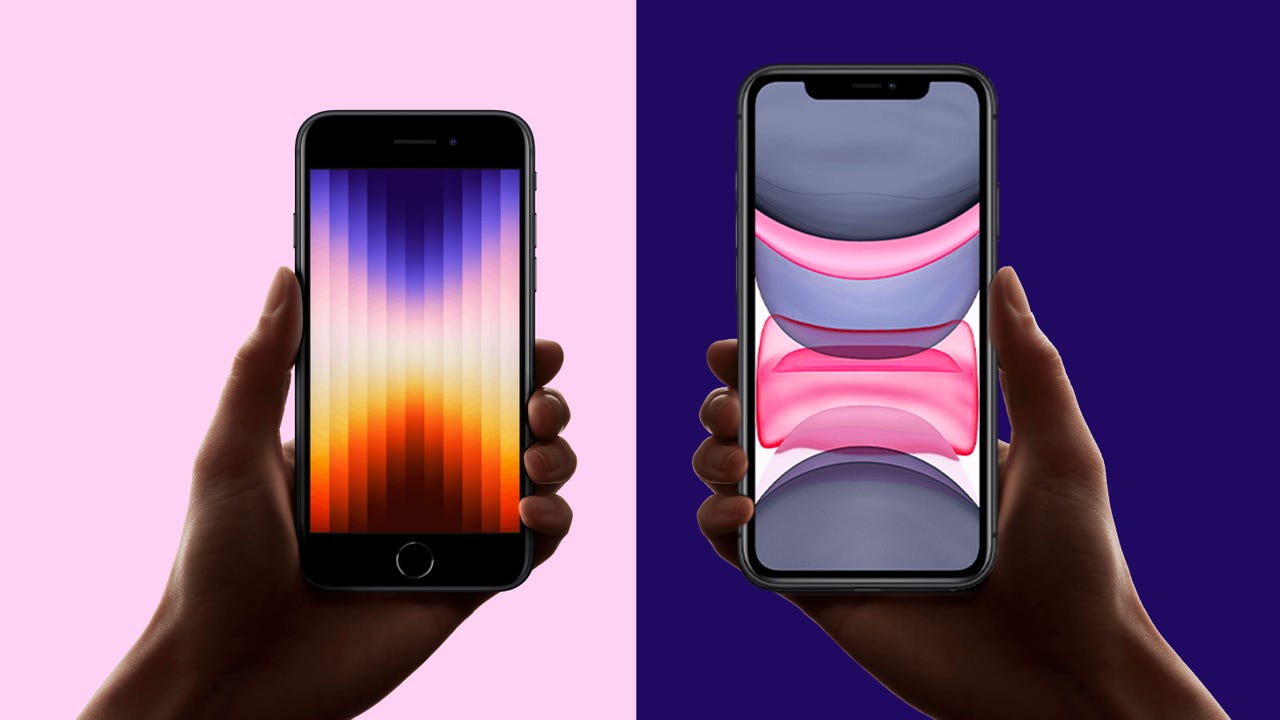































 Image: Apple
Image: Apple There's no doubt that Apple's iPhone SE is a solid smaller smartphone, priced for potential adopters on a budget. Starting at$429, the 5G-enabled, A15 Bionic-powered handset is the most affordable iPhone that Apple officially sells. But for a little less money -- and some digging around at third-party retailers -- the older but larger iPhone 11 is just as compelling of a device to upgrade to.
Whether you're eyeing the new best iPhones for a family member, significant other, or yourself, there's no question that both the iPhone SE and iPhone 11deliver exceptionally good value mobile experiences. If you're trying to decide which of the two sub-$450 smartphones you should spend your hard-earned money on, we've listed the key reasons to buy one over the other below.
Also: New iPhone models compared: Which one should you buy?
iPhone SE (2022) | iPhone 11 | |
Display | 4.7-inch Retina HD | 6.1-inch Liquid Retina HD |
Weight | 144 grams | 194 grams |
Biometrics | Touch ID (fingerprint unlock) | Face ID (face unlock) |
Colors | Midnight, Starlight, Product Red | Purple, Yellow, Green, Black, White, Product Red |
Camera | Single 12-megapixel camera | Dual 12-megapixel cameras |
IP rating | IP67 (one meter deep for 30 minutes) | IP68 (two meters deep for 30 minutes) |
| Processor | A15 Bionic (6-core) | A13 Bionic (6-core) |
| RAM | 4GB | 4GB |
| Storage | 64GB, 128GB, 256GB | 64GB, 128GB, 256GB |
| Connectivity | 5G (sub-6 GHz) | 4G LTE |
| Battery | Up to 15 hours of video playback | Up to 17 hours of video playback |
| Price | $429 | $399 |
For how much smaller and cheaper it is, the iPhone SE packs enough firepower to rival an Apple flagship. That's largely due to the A15 Bionic chip -- the same processor found in the iPhone 13 Pro -- under the hood. When 's Jason Cipriani benchmarked the iPhone SE, it scored 1,731 and 4,316 on the single and multicore tests, respectively, doubling the results of Google's highest-endPixel 6 Pro .
From a real-world perspective, that basically means the iPhone SE can run apps and games, and multitask with little to no stutter. While the iPhone 11's A13 Bionic Chip treads closely behind, it's still two generations older than the snappier SE at the end of the day.
iPhone SE (2022) brings the physical home button back.
Image: AppleThe phones' identical software experiences make it worth noting that Apple typically honors up to seven years of iOS updates. Given the three-year gap between the iPhone 11 and SE (2022), you can expect the latter to receive longer software support if purchased today. The SE is a future-proofed investment that should fare well for years down the road.
It's also worth noting that with Apple's fall release of the iPhone 14 line, Apple's in-person and online storefronts no longer sell the iPhone 11, so you'll have to purchase the handset through a third-party provider.
It's true, there's no iPhone 14 Mini this year, leaving theiPhone 13 Mini and the iPhone SE (2022) as the last of their miniature kind. While it didn't come as a surprise to see Apple cut back on its worst-performing iPhone line, the SE is still one of the best value-first, compact handsets on the market today. Most customers are probably buying the SE for its affordability and nostalgic design, but the comfortable hand-feel certainly helps, too.
Also: The iPhone 14 Mini is dead. Long live the iPhone 14 Plus
While the iPhone SE was released in early 2022, in terms of hardware it's practically indistinguishable from the iPhone SE (2020), which shared the same design as the iPhone 8 of 2017. Likewise, the iPhone 11 offers a recycled design of its predecessor, the iPhone XR. But unlike the SE, the iPhone 11 has a much more screen-dominant appearance, with a notch at the center for Face ID (face unlock) instead of the old Touch ID fingerprint sensor. It's also significantly larger than the SE, with a 6.1-inch Liquid Retina display. For entertainment lovers who desire the best viewing experience, the larger iPhone may be of greater use than the SE.
For casual and professional use, both the iPhone SE and iPhone 11 do an exceptional job of capturing photos and videos during the day or at night. The same 12MP-wide lens can be found on the back of the two devices and allows 4K video recording, optical image stabilization, and all of Apple's computational chaps -- including Deep Fusion, Smart HDR, and Night Mode.
But the iPhone 11 takes the camera just a step further by tossing in a 12MP ultrawide lens for those head-turning landscape shots. With a 120-degree field of view, the iPhone 11 can capture a wider range of subjects and provide more context than the default camera. The ultrawide lens also allows macro photography -- or close-up shots -- thanks to the smaller focal length. In general, the iPhone 11 offers more flexibility with your picture and video-taking.
If you're open to other smartphone prospects, consider these -tested offerings:
 Tags chauds:
technologie
Notre processus
Téléphones intelligents
IPhone iPhone
Tags chauds:
technologie
Notre processus
Téléphones intelligents
IPhone iPhone